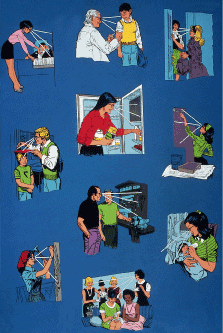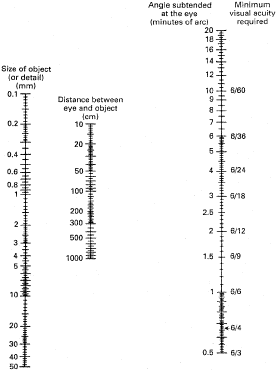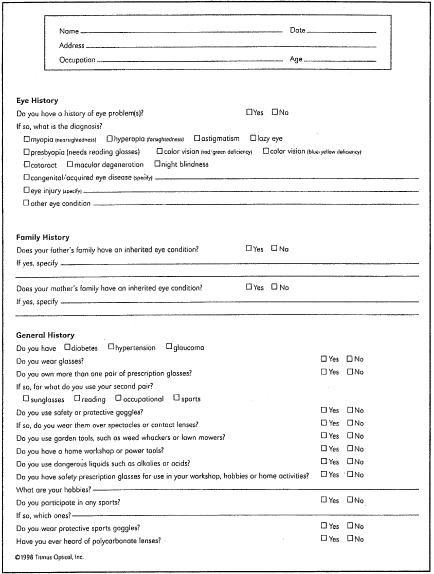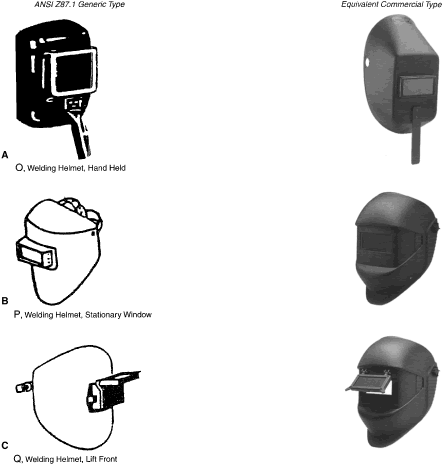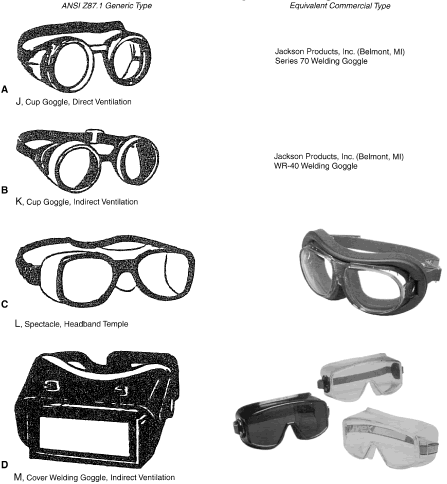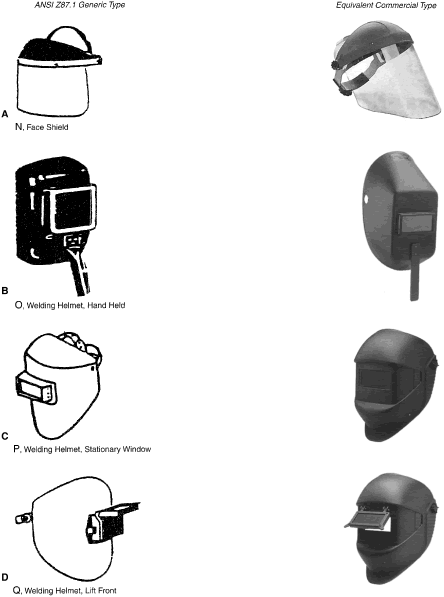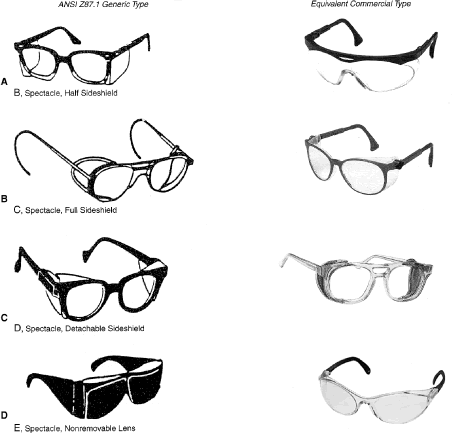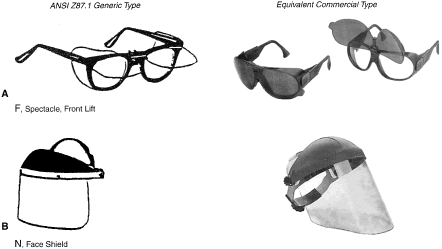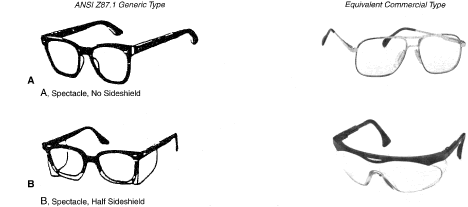THE PROSPECTIVE WORKER
To apply the preplacement examination findings, a detailed knowledge of the job is a must. Such information is derived from a visual analysis of the occupation.22
These data, or visual skills demanded of the worker, are written into the job requirements and meet with eventual tabulation.
This visual survey must be accomplished by the ophthalmologist so that he or she can get into the shops, know the jobs intimately, learn the shop language, and be completely familiar with the workers' daily environment. From this point on, the ophthalmologist is of immeasurable aid to the medical director and the personnel director who are trying to place a certain individual in a certain job, where full use of his or her capacities will be attained.
From information gained at the time of the visual analysis the eye protection required by the job is provided the worker. This is in the form of safety glasses, containing optical correction if needed, which offers protection against impact through use of special lenses. Through a single implementing device, a two-fold occupational result is obtained, specifically, good working vision and eye protection. To prescribe the proper lenses, a knowledge of the job is necessary, for occupational glasses carry with them a visual potential based on the working distance and a safety defense determined by the hazards characteristic of the job.
Each person applying for a position in large or small plants should undergo a complete physical appraisal. A part of this preplacement survey is the vision (ocular) screening procedure, which in the more progressive plants, consists of a battery of tests supplied by a single screening or rating instrument. This is a far cry from the reading of a Snellen chart, badly illuminated, badly worn, badly distanced, and badly interpreted. The basic tests offered to the new employee will help determine the worker's ability to meet the job's physical demands.22 The results from these procedures are then, in a well-integrated program, matched against the visual requirements of the job. Failure to meet the guidelines established for that particular job will place the worker and management at risk both from a safety and production standpoint. It is in this role that the ophthalmologist plays so keen a part, by interpreting from these tests the visual skills of the applicant. In large plants the ophthalmologist interprets the findings of testing done by nontechnical personnel (ophthalmic personnel, occupational nurses), or in small organizations the ophthalmologist will do the examining or the tests will be done by the primary care physicians. Data is used in cooperation with the medical and personnel directors to place that person in a job—actually fitting the eyes to the job.
THE EMPLOYEE IN HEALTH
In addition to evaluating prospective employees, follow-up and survey studies should be initiated. Workers should be checked for glaucoma, degenerative diseases of the retina, lenticular changes, and fundus evidence of systemic disease.
Diseases of the eye that are detected can be followed for further change or can be corrected if possible or recommendations can be made to management for a change in the employee's job. Rehabilitation of the limited worker is a phase of industrial health to which the ophthalmologist can contribute so much.
Visual health is maintained further by studies of illumination, machinery and desk placement, color as it applies to the equipment used, and the surrounding environs. Through the elimination of glare, malplaced and maldesigned dials, color clashes, poor contrasts for night work, and other sources of fatigue, the worker is kept in optimal visual health.
ANALYSIS OF THE WORKPLACE VISION REQUIREMENTS
Kuhn23 has suggested that three main objectives are required for an industrial eye program: (1) conducting a practical visual survey of the plant, (2) selecting adequate pre-employment tests, and (3) providing periodic rechecks of special groups.
Kuhn23 stated, “An essential and as yet hardly touched part of an intelligent appraisal of industrial eye problems, is a detailed visual job analysis. To know what a given pair of eyes must be able to do in order to place new employees according to their visual skills; in order to correct any defect properly for that work (if refractive correction is indicated); in order to choose the right type of protective equipment, one must see each and every job and codify its essential characteristics.”23 Tiffin and Wirt,24 in their Purdue University Study, analyzed the relationship of accident-free performance and visual test requirements. They suggested that there must be minimum requirements or standards of performance on the visual examination that may be demanded of any employee who is assigned to such jobs. Stump25 reviewed employees' visual performance and compared them with visual standards. He reported a 106% increase in accidents with extreme deviation from the standard, 43% with moderate deviation, and 31% with negligible deviation from the standard. In 1942, Dr. Albert Snell5 stated “good vision is that degree of visual function ability which is adequate to perform the visual task presented.” Clearly, visual function is an important factor in safety, and its improvement will allow a reduction of accidents. Studies of visual skills in relation to job performance in many types of work by Kuhn,23 Tiffin and Wirt,24 Stump,25 and others suggest that visual skills are one of the most universal and frequent factors affecting job performance. In fact, work success can often be predicted, to some extent, on the basis of visual skills such as acuity, muscle balance, and near vision.
Tiffin, in his textbook Industrial Psychology,26 noted that the Joint Committee on Industrial Ophthalmology suggested that there must be some minimum requirements or standards of performance on the visual examination. Kuhn23 proffered the concept of differentiating between separate visual standards and their relationship to the requirements of a given job. Visual requirements for employment on certain jobs or in certain plants have been established by the following3,27: (1) observation methods—standards established regarding types of testing to be used and levels of performance required for specific jobs, based on direct and expert observation of the job in question, when available or (2) statistical methods—evaluation of available facts that help determine which tests and what minimum levels of test performance most adequately identify the worker who is potentially better on a specific job.
Tiffin26 developed vision requirements to best employ, efficiently and safely, the available manpower in the 1940s. The Americans With Disabilities Act28 (ADA) of 1990 was implemented in July of 1992. It covers the hiring of employees who can fulfill the essential functions of a position, with or without accommodation, without significant risk or direct threat to oneself and to others. The purposes of both efforts are similar but approach the issue differently. In fact, it was not until passage of the ADA that a legal requirement existed for matching individual capabilities with job requirements.
Visual Requirements of Jobs
Jobs differ in visual demands they make on a worker.26 Such variations are both qualitative and quantitative. Consider the job of a crane operator. The worker is required to see clearly at a distance of 60 to 100 feet to set down the load accurately and within a narrow prescribed area. Compare the demands of that job with those of some assembly lines, where a worker may be required to see clearly materials at a very close distance to fit together quickly an intricate system of small parts and wires. The job of crane operator demands that a worker can see detail at a great distance. The ability to differentiate such detail close up is of much less importance to the job. Assembly, on the other hand, reverses the importance of these two types of visual skills. This job requires acute and comfortable vision at close range and relatively less need for such visual ability at greater distance.
The optimal use of visual skills tests for the selection and placement of industrial workers requires an accurate method of determining both the type and quantity of visual skills demanded by various industrial jobs. Mere observation of the job activity may not allow adequate determination of visual requirements. Usefulness of such tests can, however, be established by other techniques described below.
OBSERVATION TECHNIQUE
Visual Task Analysis
Before the vision screening for a worker can be recommended, there should be an analysis of the visual tasks required by the job. Analyzing the visual factors required for a task is of crucial importance.29 Ideally the analysis should be performed at the place of work (e.g., the factory or office). Factors, such as distance and size of the critical details of the task, should be assessed, along with need for color discrimination; depth perception; body, head, or eye postures; field of vision; eye movement requirements; and the contrast and illumination at the job site. Important visual factors can be identified in this manner, and this analysis fulfills regulatory requirements of the ADA28 and Occupational Safety and Health Act [Occupational and Health Administration (OSHA)] 29 CFR 1910.132.30
A plant “walk-thru” offers the opportunity for the physician to accomplish several tasks. Plant illumination lighting and the visual requirements of specific jobs can be scrutinized. General hygiene and compliance with necessary personal protective equipment (PPE), such as safety glasses, can be noted. The OSHA log can give valuable information about injury patterns. Safety equipment, such as eye wash booths, can be inspected.
North developed a useful job checklist (see Table 1) for the analysis of visual requirements for each job in the workplace. It entails a careful survey of each component of a given job in relation to the employee's visual skills used in the performance of his or her tasks.31 This analysis requires a broad knowledge of visual abilities and limitations (problems of accommodation, convergence, presbyopia, coordination, muscle balance, etc.) lighting, physical factors, and the host of eye hazards of the particular operation. The visual survey is best accomplished as a cooperative venture that may include contributions from the plant medical director; the consulting eye physician; production, illumination, and safety engineers; the personnel director; and supervisors. In some instances, one person with unusual knowledge and experience can qualify and evaluate these various skills. Proper vision is an important factor in industrial efficiency and has a marked bearing on output and on safety. Adequate measurement and classification of visual requirements of a job is one of the most effective means of determining the potential efficiency of applicants for jobs. By the same means, it is possible to increase the efficiency of employees on the job.
TABLE 1. Check List of Visual Job Analysis
- Job description (including qualifications relative to type of training
and skills) with standard code number.
- Distance or distances (distance for acuity and/or near acuity) in inches
or feet from eyes of worker to point of operation, fixed or changing.
- Motion of work (distance and near muscle balance): slow or rapid rotation, vertical
or horizontal, fixed or intermittent.
- Size of central working area, depth perception factors (stereopsis).
- Type of visual attention required: fixed or changing, casual or concentrated, detailed
or gross (or listed as perfect, average, or defective
permissible; or as class A, B, or C).
- Colors to be perceived and discriminated.
- Foot candles of illumination at workpoint, as well as in surrounding area. Direction
of light (note any harmful shadows). Reflected or direct
glares (to be eliminated if possible). Brightness ratios (avoid sharp
contrasts).
- Color of light source and work area (functional painting, etc.).
- Type of working surface: glossy or nonglossy, slightly or grossly uneven. Angle
of working surface. Position of work in relation to normal level
of eyes, viz., does worker have to look down, ahead or upward (determine
whether bifocals are permissible or a handicap).
- Eye hazards: flying objects, particles of dust, fumes, splashing chemicals, or
molten metal; airborne matter; radiation, and so forth.
- Type of eye protection required.
VISUAL ERGONOMICS OF THE OFFICE WORKPLACE.
Visual symptoms can usually be resolved with a combination of ergonomic changes in the environment and the provision of appropriate visual care to the computer worker (Fig. 1). Studies indicate that visual complaints occur in 50% to 90% of workers who use VDTs.17,19,32,33,34 These problems result from visual inefficiencies or from eye-related symptoms caused by a combination of individual visual abnormalities and poor visual ergonomics. The problems occur whenever the visual demands of the task exceed the abilities of the individual.34 Such difficulties are real and prevalent. The basis for most of the problems is understood.
|
|
The ability to perform most tasks depends on many visual and nonvisual variables.29 The factors that influence the visual performance include the visual capability of the individual, the visibility of the task, and psychologic and general physiologic factors. However, such factors must be considered because they can significantly influence visual performance. It is not within the scope of this chapter to deal with the third group of factors in depth, although psychologic and general physiologic factors, such a motivation, intelligence, general health, and so forth should not be forgotten, because they can all influence the visual performance. This chapter deals in detail with the first two variables—visual capabilities and the visibility of the task.
Ergonomic Tactics to Prevent Visual Fatigue and Other Visual Disorders
Visual fatigue is a term used to describe phenomena related to intensive use of the eyes. It can include complaints of eye or periocular pain, itching or burning, tearing, oculomotor changes, focal problems, performance degradation, “after colors,” and other phenomena.35 There are ergonomic tactics that can be used to prevent or reduce visual fatigue.
Ergonomic research supports the following regarding VDTs:
- Placement of frequently used displays in the primary visual display area. The
top of this area should be opposite the operator's eyes, with
the eyes facing straightforward, extending down to a point at which
the operator is looking down at a 30-degree angle. Devices viewed as
they are operated, such as buttons, keyboards, and controls, should be
above and below this area, at the work surface, and above the plane
of the operator's eyes.
- The optimal viewing distance for visual displays is about 50 cm, or 20 in. Corrective
lenses designed specifically for the job can be used for
workers with refractive error or presbyopia. Lenses of this type can
be incorporated into multifocal eyeglasses (progressive add lenses with
overviews) as well.
- Proper illumination is important. It should be evaluated for each task.
- Visual performance can be impaired by whole-body vibration in the range
of 10 to 25 cycles per second. Such vibration, which may be generated
by power saws, cranes, conveyors, and other machinery, should be damped
or separated from the worker.
The Visibility of Tasks
The ability to perform a task safely, efficiently, and comfortably depends on its visibility, as well as on the visual capabilities of the employee, as outlined.29 Naturally, the better the visibility, the easier it is to perform the task. The factors that influence the visibility of a task are
- Size of task.
- Distance of task.
- Illumination.
- Glare.
- Contrast.
- Color.
- Time available to view task.
- Movement of the task.
- Atmospheric conditions.
SIZE OF TASK.29
The size and critical detail of the task must be taken into account so that the angle subtended at the eye, and hence the visual acuity necessary to perform the task comfortably and efficiently, can be calculated. The retinal image size of any object is inversely proportional to its distance from the eye. Therefore, objects may differ greatly in physical dimensions but form similar retinal image sizes because they are viewed at different distances. Although the visual acuity may be the same, the demands made on accommodation and convergence may be different (Fig. 2). A very small object may have to be placed very close for the detail to be large enough to be resolved, but this will require good accommodation and convergence.
|
Static Acuity.
Static acuity is the capacity for seeing distinctly the details of a stationary object. This should be related directly to size and distance of the smallest detail required to be seen in the assigned task. Numerous factors, according to North,29 can influence the ability of the visual system to see details. These include luminance, contrast, spectral nature of light, size and intensity of surrounding field, region of retina stimulated, distance and size of object, time available to see object, glare, foggy or steamy atmosphere, refractive error, pupil size, age, attention, IQ, boredom, ability to interpret blurred images, general health, and emotional state.36,37
The choice of safety glasses is especially critical for individuals who have a loss of accommodation (presbyopia) or must use contact lenses in the workplace. A presbyopic lens should provide for the lack of accommodation so that the user can perform visual tasks efficiently and effectively in accordance with the essential functions of the position. The occupational presbyopic lens should attempt to mimic the normal accommodative process and provide a physiologic amplitude of accommodation. The occupational eye care provider should prescribe lenses to allow the performance of essential visual tasks (Fig. 2) comfortably with good visual and body ergonomics.
Vernier Acuity.
The type of visual acuity discussed so far has been form acuity—the ability to discriminate between two small parts of an object. However, in some occupations line detail is required, for example, the use of micrometers or precision gauges requires the discrimination of a break in contour or alignment, that is, vernier acuity. The visual system is extremely sensitive to these details and it is approximately one twentieth of the corresponding angle for details to be resolved in form acuity.38 If the form acuity for a certain distance is known, then it is relatively easy to calculate the equivalent visual angle for vernier acuity and the actual size that may be resolved and vice versa. Misalignments of segments of a divided line of approximately 3 seconds of arc can be detected at moderately high levels of illumination, whereas the minimum angle of resolution is between 30 to 60 seconds of arc.37
CONTACT LENSES IN THE WORKPLACE.
The AAO and ACOEM Joint Policy of Wearing Contact Lenses in the Workplace stated, consistent with the ADA,39 that individuals should not be disqualified from performing their essential functions in an industrial environment because they wear contact lenses unless it can be proved that they pose a direct threat and substantial risk to the health or safety of themselves or others in the workplace. The 1998 revision of the Code of Federal Regulations on Respiratory Protection allows for contact lenses under a full-face respirator.40 Although contact lenses provide some protection, they do not fulfill the ocular safety standards, so the required industrial safety eyewear for the specific hazard identified in American National Standards Institute (ANSI) Z87.141 must be worn over them. Blais27,42,43 has provided evidence that contact lenses are neither a direct threat nor a substantial risk in the hazardous environment.
There are numerous other factors, according to North,29 that physical, physiologic, and psychologic, which can influence the ability of the visual system to see details. These can be listed, in addition to the previous list, as follows: spectral nature of light, intensity of surrounding field, region of retina stimulated, distance and size of object, foggy or steamy atmosphere, refractive error, pupil size, age, ability to interpret blurred images, and general health. The following should be considered under the category of psychologic and physiologic: attention span,36 IQ, boredom, and emotional state.37
DISTANCE OF THE TASK.29
Naturally, the distance of the task from the observer and the size of the detail of the task affect the retinal image size, and hence the visual acuity required to distinguish it. The distance of the task also determines the level of accommodation and convergence and the degree of uncorrected refractive error or phoria that may be tolerated. Working distances may be classified as: far (greater than 2 m), intermediate-to-near (less than 2 m and greater than 30 cm), and very near (less than 30 cm).38 Examples of tasks involving far working distances include driving a vehicle and flying an airplane; intermediate-to-near tasks include secretarial work, VDT operation, and lathe operating; and very near tasks include sewing, micro-electronics assembly work, and watch repairing (see Fig. 2).
The amount of accommodation decreases with age and after their mid-40s workers require a spectacle prescription to focus near objects clearly and comfortably as the range of accommodation reduces with age; the range of clear vision through the near vision addition becomes smaller. Workers with poor visual acuity may also benefit from increased lighting levels and from more magnification to increase the retinal image size.33,44,45
ILLUMINATION.
Proper illumination is important and it should be evaluated for each task. The relationship between illumination on the task and performance achieved will vary according to the type of task.29 The effect of illumination on task performance will vary according to
- The visual difficulty of the task.
- The extent to which the visual part of the task determines the overall
performance.
The greater the visual difficulty, the greater the effect of the illuminance, whereas in a task such as audio typing, in which there is only a small visual component, the effect of illuminance on the overall task performance will be small. It is dependent on the needs of the task, reflectance of surfaces in the area, and, to some extent, the age of the worker. Older workers generally require brighter lighting for visual discrimination. In general, illuminance of 70 to 80 foot candles (ft-c) is needed for general office work, 100 to 150 ft-c for visually intensive tasks, and up to 500 to 1000 ft-c for very fine tasks.29
GLARE.
The effect of veiling reflections and the complexity of the task have a significant effect on job performance.29 Veiling reflections are due to light from a high luminance surface, such as a luminaire, being reflected from a specular surface, which is being viewed. These veiling reflections cause a reduction in performance because of the decreased contrast created on the task by the superimposed reflections.
Lighting geometry should be configured to avoid glare. Glare on a VDT screen, for example, should be reduced by
- Placing visual display terminals out of direct line with or facing windows.
- Using window films and coverings.
- Using dull, textured surfaces.
- Reducing ambient lighting to below 500 lux (18 to 46 ft-c) and using supplemental
lighting where needed.
- Using indirect lighting.
- Using parabolic louvers on fluorescent lights.
- Shielding of auxiliary lighting.
- Using eye shades.
Visual discomfort from glare and other sources accumulates during the work day, and task rotation may be a reasonable preventive measure if other adjustments are not successful.
CONTRAST.
The eye detects objects by responding to the differing levels of illumination at the target edges, or contrast29:
Contrast = <fr background illumination - target illumination/background illumination>
To determine the optimal illumination levels for a task, the contrast and size should be measured. It is difficult to measure the contrast of a practical task. These vision standards, either mandatory (e.g., DOT) or voluntary (Purdue Standards), apply to tasks of normal contrast and reflectance. If, however, the contrast or reflectances are low and mistakes are made because of wrong perception, these are likely to be dangerous or costly. The recommended illumination should be increased to compensate for the decrease in contrast of the object considered.
Concerns regarding the visibility of tasks have influenced the American codes for lighting.46 The initial experiments carried out investigated the threshold detection of static disc targets, and later experiments involved the detection of dynamic targets. The dynamically presented targets were believed to create conditions more similar to a practical task. More recent studies have investigated the effects of lighting on the visual performance of a 20- to 30-year-old age group.47 Older individuals require more light than younger ones to perform a similar task.29
COLOR.
Deficiencies can be either congenital or acquired. The ability to discriminate colors is particularly influenced by age and illumination. It has been shown that with age there are more errors in hue discrimination in the blue-green and red regions.48 This study showed that the number of sorting errors in the FM 100 hue test could be reduced by increasing illumination.48,49
TIME AVAILABLE TO VIEW TASK AND MOVEMENT OF THE TASK.
The time available to see the task is important; too short a time exposure will reduce the visibility, especially if the task is moving.29 The time available to view the letters and so forth will influence the visual acuity measured. It has been estimated that a person can transmit up to 10 bits/second (a bit is a unit of information processed in a second) of visually displayed information. This is a very small amount of information, when it is estimated that the human sensory system has a capacity to transmit millions of bits per second. Therefore, it is not only the input of the visual system that limits the visual performance but the processing, decision making, and motor output. Letters can usually be recognized in under a second, and, obviously, the better the illumination and the larger the letter, the faster the recognition time.
ATMOSPHERIC CONDITION.
Atmospheric conditions in such industries as foundries and mining, in which there may be dust, smoke, or steam, will reduce visibility because of the absorption of light.29
Interactions of Luminance, Contrast, and Glare
Three major factors that influence visual acuity are luminance, contrast, and glare. The influence of luminance on visual acuity may be plotted (Fig. 3). The capacity of the visual system to resolve details increases with increasing luminance, although there is a level beyond which visual acuity does not increase; in fact, it may diminish because of disability glare. Contrast has a maximal effect on visual acuity at low levels of illumination but has a minimal effect at high levels.
Spalton and colleagues,50 in their slide atlas of ophthalmology, state that the graph of visual acuity plotted against contrast shows the rapid improvement in acuity as contrast increases and the difference that background illumination makes to the acuity under the same conditions of contrast (Fig. 4). In clinical acuity tests black letters are displayed on a white background giving a contrast value of approximately 80%. In the normal eye under photopic conditions the threshold contrast is about 1%.
The following example relates the association of distance and decreased contrast. The eye with a visual acuity of 20/40 visualizes a 1.0 mm-target at 14 in. (35 cm). At 28 in. by doubling the distance without change in size, the eye will require a visual acuity of 20/20 with high contrast. Using Figure 4, working at moderate contrasts would require a visual acuity of 20/05, a visual acuity not readily available in most human beings. In essence, doubling the distance doubles the visual requirement, and decreasing the contrast also doubles the visual requirement.
Visual Factors for Specific Task
There are occasions when on-site analysis is not possible. A logical method for determining the visual factors required for a particular task was devised by Grundy.51 From the knowledge of the distance and size of the critical detail of the task, the visual acuity necessary to discriminate the smallest detail can be determined. This can be calculated easily from a simple graphical method by using a nomogram, shown in Figure 5. For example, a task has a critical detail of 0.6 mm and is viewed at 70 cm. When a straight line is drawn through these values it will intercept the right-hand scale to indicate that the corresponding visual angle is 3.0 minutes of arc and the minimum visual acuity required is 6/18. It is important to remember that the values given are a measure of the resolving power of the eye, and higher standards are required for the task to be carried out for prolonged periods. It has been suggested that the visual acuity necessary for a demanding task should be approximately twice the minimum value.52 Therefore, in the previous case, a visual acuity of 6/9 is advised. The employee can often move closer to the task, increasing the angular subtense at the eye, but this depends on the amount of accommodation and convergence available. The older presbyopic employee, who has a reduced amount of accommodation, may need an intermediate and a near prescription, depending on the distance of the task.
|
Steps in Setting Standard—Observation Techniques
After analysis of the visual task in which the important visual factors are determined, a standard can be set by either: (1) choosing a standard believed to be necessary to work efficiently and safely, for example, VA 6/12, distinguish principal colors—for red, green, blue, and yellow hues. This can be tested by relating visual competence to job competence as described previously; or (2) insisting on the normal level of visual capabilities for each factor chosen, for example, VA 6/6, normal color vision (red and green hues). This approach would exclude some who were capable of performing the task comfortably yet could not meet the selected standard.
STASTICAL METHODS
Joseph Tiffin and his associates of the Division of Education and Applied Psychology, Purdue University and the Bausch & Lomb Industrial Vision Services,26 used a statistical basis to solve problems of visual standards. A number of existing employees on specific jobs—employees of all degrees of ability and achievement—were tested. These employees were classified on the basis of production, quality rating, or other available measures of job success into categories that ranged from “definitely superior” to “definitely inferior.” The visual characteristics of the different groups were compared to determine how visual skills of the superior workers compared with those of inferior workers. Because measurements of job performance are influenced by the amount of training and experience on the job, as well as by aptitudes and skills, careful handling of the data was required.
Visual-skill records of more than 150,000 employees associated with more than 200 companies were tabulated and analyzed. These employees occupied more than 2000 different jobs. Wherever possible, individual records of job performance were obtained for each employee. Visual-performance test scores and job-performance results, as well as a record of age, experience on the job, sex, and other pertinent facts, were recorded and tabulated.
The visual-performance requirements for each job were determined from the resulting analyses. Employees with substandard visual performance were identified and referred by their employing company to local practitioners.
VISUAL STANDARDS
General
The purpose of visual screening tests as part of a job evaluation is to compare the visual performance level of an applicant to the demands of the job.23
Statisticians have shown that careful study of the visual skills found to be associated with successful employees can predict the future success of comparable applicants. On this data, the actual basis of pre-employment standards are built. Medical people are trained on the whole to deal with sick and/or defective and physically unimpaired people. Their approach to examinations of a physical organ, such as the eye, and its relationship to a given task, is to think of the defects that prevent a person from doing that task. They seek to separate out misfits. The psychologist and the statistician separate out those who are successful. They are interested in finding those who have the physical skills to fit the requirements of a given task. They are interested in those who do qualify, whereas doctors are interested in discovering those who do not qualify. It is important to keep this distinction in mind. If thoroughly understood, it forms the basis for a much clearer understanding between groups who need to work more closely together, namely, statisticians and doctors.53,54
Vision and Job Proficiency
Studies of visual skills in relation to job performance by Kuhn,21,23 Tiffin and Wirt,24 Stump,25 and others in diverse work environments have demonstrated that various visual skills frequently affect job performance. The importance of adequate vision in industry can be satisfactorily demonstrated only in relation to acceptable industrial criteria, such as hourly production, the proportion of work rejected for defective workmanship, supervisors' ratings of employees, employee absences, rate of labor turnover, or other measurable aspects of an employee's value to the company.55 Vision characteristics that correlate with these industrial criteria differ from job to job and cannot consistently be predicted without correlating evidence. There are many qualities of the worker's performance on the job that contribute to his or her degree of job success.52 The most obvious aspect of job success is the amount of work produced by the individual within a given time. Individuals vary in the number of pieces they can produce per hour even though they are working on identical machines and may appear to be working under identical job conditions. Visual skills are one of many factors that contribute to this difference. Visual skills that allow the greatest degree of accuracy, however, may not be the same as those required for greatest degree of speed of work. Management must assist in the determination of the most critical criteria.
Good functional vision can be achieved in most cases with professional eye care. Abundant evidence supports the concept that visual functions are important factors in safety. The provision of appropriate eye care can allow most employees to meet visual standards, and a reduction of accidents may result.
TYPES OF RELATION.
It has been demonstrated on many different jobs that employees who have been classified according to their job proficiency do differ with respect to certain visual skills. Those who do the job best usually have certain visual characteristics that are not found as frequently, or to the same degree, among those who do not do it as well.
PATTERNS OF VISUAL REQUIREMENTS.
Each test in the battery of vision tests is separately analyzed in relation to job success. Some of the tests may show a relation to success on a particular job, others may not. On each related test, a range of scores is designated as optimum for the job. The total pattern of these visual requirements represents the pattern of visual skills that is predictive of success on this job. Such a pattern, or profile, of visual requirements for close work is illustrated in Figure 6.
|
Vision and Successful Job Performance
There are many qualities of the worker's performance on the job that contribute to the degree of job success.56
PRODUCTION.
The elements that make up production are measurable as number of pieces produced, earnings, and waste or rejects and in ratings given by supervisors.53 “Different visual characteristics will vary in their relative importance on different small assembly operations; and on any one operation, visual characteristics will vary in importance with respect to different industrial criteria, such as quantity and quality of work.”26
TURNOVER.
A further difficulty often encountered by industrial management is the problem of labor turnover. Much needless expense is incurred in the training of new employees who, after such training, remain on the job only a short time. The elimination of these applicants who have a low predictability of success can reduce the problem. Visual testing plays a role in this success.
